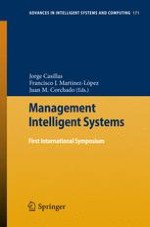The 2012 International Symposium on Management Intelligent Systems is believed to be the first international forum to present and discuss original, rigorous and significant contributions on Artificial Intelligence-based (AI) solutions—with a strong, practical logic and, preferably, with empirical applications—developed to aid the management of organizations in multiple areas, activities, processes and problem-solving; i.e., what we propose to be named as Management Intelligent Systems (MiS).
The three-day event aimed to bring together researchers interested in this promising interdisciplinary field who came from areas as varied as management, marketing, and business in general, computer science, artificial intelligence, statistics, etc. This volume presents the proceedings of these activities in a collection of contributions with many original approaches. They address diverse Management and Business areas of application such as decision support, segmentation of markets, CRM, product design, service personalization, organizational design, e-commerce, credit scoring, workplace integration, innovation management, business database analysis, workflow management, location of stores, etc. A wide variety of AI techniques have been applied to these areas such as multi-objective optimization and evolutionary algorithms, classification algorithms, ant algorithms, fuzzy rule-based systems, intelligent agents, Web mining, neural networks, Bayesian models, data warehousing, rough sets, etc.
The symposium was organized by the Soft Computing and Intelligent Information Systems Research Group (http://sci2s.ugr.es) of the University of Granada (Spain) and the Bioinformatics, Intelligent System and Educational Technology Research Group (http://bisite.usal.es/) of the University of Salamanca (Spain). The present edition is held in Salamanca (Spain) on July 11-13, 2012.
